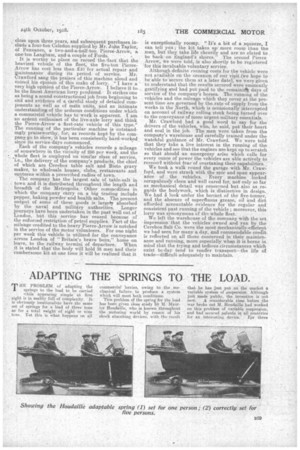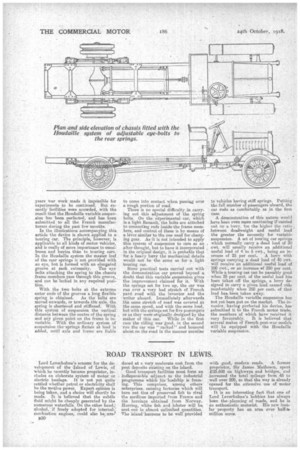ADAPTING THE SPRINGS TO THE LOAD.
Page 9

Page 10

If you've noticed an error in this article please click here to report it so we can fix it.
THE PROBLEM of adapting the springs to the load to be carried while appearing simple' at first sight is in reality full of complexity. It is obviously irrationaNto have the same set of springs for a load of three tons as for a total weight of eight or nine , tons. Yet this is what happens on all
commercial lorries, owing to the _mechanical failure to produce a system which will meet both conditions.
This problem of the spring for the load has been given close study by M. Maurice Houdailie, who is known throughout the motoring world by reason of his shock absorbing devices, with the result that he has just put on the market a variable system of suspension. Although just made public, the invention is not new. A considerable time before the war broke out M. Houdaille had worked on this problem of variable suspension, and had secured patents in all countries
for an interesting device. Fpr three years war work made it impeissible for experiments to be continued. But recently facilities were accorded, with the remit that the Houdaille variable suspeneion has been perfected, and has been submitted to all the French manufacturers during the past few months.
In the illustrations accompanying this article the device is shown applied to a touring car. The principle, however, is applicable to all kinds of motor vehicles, and is really of more impertance to mini: buses and lorries than to touring cars. In the Houdaille system the master leaf of the rear springs ill not provided with an eye, but is formed with an elongated groove at each extremity. The eye bolts attaching the spring to the chassis frame members pass through this groove, and can be locked iui any required position.
With the two bolts at the extreme outer ends of the grooves a long flexible
spring is obtained. As the bolts are moved onwards, or towards the axle, the spring is shortened and stiffened. With this system of suspension. the vertical distance between the centre of the spring and any given point on the frame is invariable. With the ordieary system of suspension the-springs flatten as load is added, until axle and frame are liable
to come into contact when passing over a rough portion of road.
There IS no special difficulty in carrying out this adjustment of the spring bolts. On the aperimental ear, which is a light Renault, the bolts are attached to connecting rods inside the frame members, and control of these is by means of a lever similar to the one used for changing gear. As it is" not intended to appiy thus system of suspension to cars as an after-thought, but to have it incorporated in the original design, it is probable thee for a heavy lorry the mechanical details would not he the same as for a light touring ear.
Some practical tests carried out with the demonstration ear proved beyond a doubt that this variable suspension gives the improvement claimed for it. With the springs see for two up, the car was run over a very bad stretch of French pave road with the inventor and the writer aboard. Immediately afterwards the same stretch of road was covered at the same speed, and with the same load, but with the springs set for five passengers or as they were originally designed by the maker of this car, While in the first case the riding was-good, in the second run the car was "racked" and bounced about on the road in the manner peculiar
to vehicles having stiff springs. Putting the full number of passengers aboard, the car rode as comfortably as in the first case.
A demonstration of this nature wonll have been even more convincing if carried out on a lorry, for the higher the ratio between deadweight and nsefal load the greater the necessity for variable suspension. A set of touring ear springs which normally carry a dead load of 20 cwt. will usually receive an additional useful load of 4 to 5 cwt.' being an increase of 25 per cent, A lorry with springs carrying a. dead lead of 4.0 cwt. will receive an additional useful load of 100 cwt:, or an increase of 250 per cent. While a touring oar can be passably good when 25 per cent, of the useful load has been taken off the springs., a lorry designed to carry a given load cannot ride comfortably when 250 per cent. of that load haa, been taken away.
The Houdaille variable, suspension has not yet been put on the market. The inventor, haying perfected his device, has submitted it to the French motor trade, the members of which have received it very favourably. It is believed that several makes of French post-war models will be equipped with the Houdaille variable suspension.






















